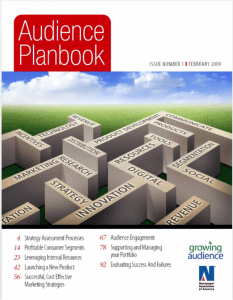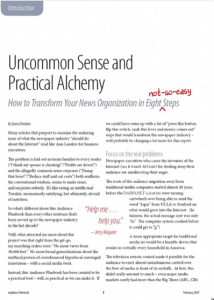The Big Scary Project that I’ve been yammering about for the last five months is finally live & open for business.
The Audience Planbook was designed to guide newspaper execs through the process of transforming their familiar (but no longer safe) businesses into popular & profitable New Media information centers. Here’s what the front page looks like:
This Planbook is an answer to one of the most persistent and trenchant objections to all this “New Media Strategery” — that is, that previous case studies and industry analyses have been long on strategy, and short on tactics. There are hard drives bursting with essays, webinars and podcasts calling for “disintermediated information flows” and “leveraging Web 2.0 to enhance user experience,” but the practical means by which to transmute these philosophies into concrete policies & procedures has been lacking.
No longer.
I’d like to publicly thank & brag about my writers:
Chapter 1: Stacy Lynch writes about how to assess your current situation to spot where opportunities exist – even in this down economy & print-hostile environment.
Chapter 2: Heather Schlegel (aka Heathervescent) shows how to construct User Personas to start focusing in on audience groups that you want to turn into readers/users/contributors/evangelists.
Chapter 3: Chris Willis takes on one of the toughest problems in media organizations: the change-resistant culture, and shows how to start the internal change that will then manifest itself as an external renaissance.
Chapter 4: Francis Pisani brings a breath of fresh air to the product launch process – his experience as an “Alpha Blogger” in France & Spain brought him into contact with tech teams that are doing spectacular things.
Chapter 5: Sean McDonnell uses his experience of working to build communities for the banking and financial sector to show off the newest viral marketing tools.
Chapter 6: Erik Johnson shows how to push, pull, coax and haul our audiences up the engagement ladder; because an engaged user is far more valuable than a drive-by browser.
Chapter 7: Janine Warner dissects the business and organizational structures that New Media companies are using to produce this kind of content.
Chapter 8: Kevin Featherly takes the results of all this labor, and shows how to make an informed decision to “hold ’em or fold ’em.”
I am tremendously proud of the work that they all have done. We are all trying to peer into cloudy crystal balls here, and they have uncovered some real gems.
The Hedgehogs Know One Big Thing – And They’re Talking to Each Other
We set out from the very beginning to avoid the “view from 30,000 feet” essays in favor of identifying as best we could specific tools & techniques that managers could start to use to transform their operations.
I write a lot more about that in my introduction:
It is my hope that the recent trend of newspapers actually dropping their guards a bit and talking to each other (and who knows – maybe even cooperating a little) is going to increase. Not just because it’s nice to see all the kids in the sandbox play nice, but because this looks like the only way the industry is going to come out the other side of this crisis.
I’ve just looked at this Planbook again, and counted the pages. More than 100. Gads. I can’t believe I actually edited this thing and it came out coherent.
There’s a lot of content there. I’ve tried to break things up as much as I can, and to provide shortcuts & bullet points to make the info-uptake as smooth & easy as possible.
But I kinda feel like Winston Churchill in the spring of 1940, promising the listeners in a famous radio broadcast, “Blood, toil, tears and sweat,” but also conveying, through the iron certainty in his voice, that there was a way out of the crisis, and that they would “never surrender.” He had a vision – one Big Thing – and he stuck to it.
I am often asked if I think there is any kind of a future for the newspaper industry. Usually the question is accompanied by lifted eyebrows, and the kind of tone you use on a 9/11 conspiracy theorist.
Well, break out the tinfoil hat. Yes, I think newspapers have a future. I even think that there will be ink-on-deadtree editions.
They are just not going to look like the things we’ve all known our entire lives. Which is OK.
I grew up with music on LPs and 8-track tapes. Moved to cassettes and CDs. Now it streams into my computer through a cable modem.
Musicians are still creating and I’m still listening and feeling uplifted/inspired/touched/angry/exultant. Journalists, photogs, videographers, etc., will still keep capturing the little slices of reality for their audiences.
Please go to the Growing Audience blog and add your thoughts, comments and experiences to the mix.


